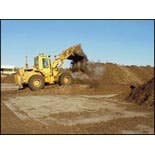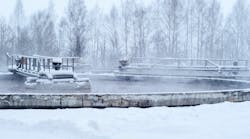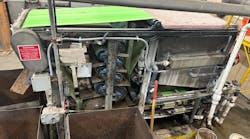Many utility providers face growing problems with the disposal of the wastewater sludges (residuals) that are created as part of the wastewater treatment process. Other providers are looking to additional methods for converting the residuals into fertilizer/soil conditioner with a higher economic and social value. The new technology presented in this paper provides a composting method to address the disposal and/or use of wastewater residuals. By maintaining the recommendations presented in this paper, a Class A biosolid can be produced. This Class A biosolid provides the utility operator the maximum flexibility for its disposal or use as a fertilizer, soil conditioner, etc.
Composting of wastewater residual is a bio-thermal aerobic process that decomposes the organic portion of the residuals. The composting process reduces the organic material in the residual by approximately 25 percent. During composting the heat generated by the decomposition of the organic portion of the residuals reduces the moisture content of the residual, stabilizes it and renders the residual harmless by transforming it into a usable biosolid.
Organic content
In general, the higher the residual’s organic content, the greater the quantity of heat released during composting. More heat results in the thermophilic phase (55 to 65° C) being reached earlier in the composting process. This greater heat release results in more moisture being evaporated. Raw residual typically contains 60 to 80 percent organic material, while digested residual contains only 30 to 50 percent organic material. Since raw residual (from primary clarifiers and secondary clarifiers) contains more organic material than digested residual, it is reasonable to prepare compost from dewatered raw residual. By utilizing raw residual the digesters, pipe, pumps, electrical power, personnel, etc., normally used in the digesting process can be reduced or eliminated.
The heat generated by composting 1.0 kilogram (kg) of organic material averages 21 Million Joule (Mjoule). Approximately 4.0 Mjoule of heat will evaporate 1.0 kg of moisture (taking into account heat losses and heating of the compost material). Thus, the composting of 1.0 kg of organic material facilitates the removal of approximately 5.0 kg of moisture from the residual. [21 Mjoule / (4 Mjoule/kg of water)].
Before composting, it is necessary to dewater the residual. Dewatering not only reduces the volume of the residual but also decreases the amount of moisture to be evaporated by the composting process.
Odor
A problem with composting raw residual is the higher intensity odor that can be released due to the higher percentage of organic material in the raw residual. While various methods can be used to control the odor, the authors favor the addition of quick lime (CaO) to change the pH of the residual. Experiments show that organic material loses its odor when the pH is raised from the typical 5.5 to 6.5 to a pH of 10.0 to 10.5. In addition to changing the pH of the residual, the hydration of the quick lime (absorbing moisture from the residual) causes the quick lime to release heat to the residual. During the process of hydrating 1 kg of chemically pure quick lime (100 percent CaO) 1,152 Kilojoules of heat is produced, requiring 320 grams of moisture/hydration from the residual. This release of heat shortens the time span of the mesophilic phase (25 to 40° C) and drives the process to the thermophilic phase (55 to 65° C) quicker, resulting in an overall reduction in the composting time. If odor continues to be a problem, the simple procedure of drawing air through the compost piles and discharging the air to a bio-filter can further reduce the associated odor.
Temperature and moisture
The temperature increase caused by a predetermined dose of quick lime may be calculated by the following formula
DT = (1152 * A * Mi) / [(Msi * Csi) + (Mi * Ci)]
Raising the residual temperature by 10° C doubles the speed of the microbiological activity that accomplishes the composting process.
The addition of quick lime absorbs moisture from the residual, thereby reducing the moisture content of the compost mixture. The residual moisture content after the addition of quick lime can be calculated using the following formula:
Wk = [(Mst * Wsi) – (0.32 * A * Mi)] / (Msi + Mi) (3)
Wk = moisture content (in decimals) of the residual after the addition of quick lime
The lowering of the moisture content of the residual decreases the volume of the residual. This decreases the amount of quick lime required to raise the pH to 10.5. Therefore, it is reasonable to dewater the residual prior to the addition of quick lime.
Composting mixture
The new compost technology presented in this paper requires quick lime to be mixed with the dewatered residual prior to adding a bulking agent (sawdust, peat, woodchips, bark, hydrolyzed liquin, etc.) and recycled compost. A technological schematic of raw wastewater residual composting process is shown in Figure 1. Once the quick lime and residual are thoroughly mixed, the bulking agent and a portion of recycled compost are added and mixed. This mixture then is formed into piles and allowed to compost until a temperature of 55 to 65° C has been maintained for 3 to 11 days. The piles often are covered with a layer of bulking agent or recycled compost to protect the pile from heat loss as well as avoid attracting flies, mosquitoes and other undesirable insects. A list of recommendations for the mixture is shown in Table 1.
Compost process control
Experiments show that the type and population of microorganisms varies during the composting process. Therefore, it is critical to control the composting environment so that the microorganisms can flourish. The composting environment parameters include the compost pile temperature, moisture content of the compost, oxygen and carbon dioxide levels in the compost pile and the availability of nutrients including carbon, nitrogen, phosphorus and potassium for the microorganisms. These parameters must be monitored as they affect the vitality of the microorganisms.
The temperature in the compost pile most directly affects the type of microorganisms and their functions. The type of microorganisms change as the compost pile temperature increases from its initial temperature to the mesophilic phase to the thermophilic phases and to the slow decrease in temperature following to completion of the composting process. Experiments show that the thermophilic phase must be maintained for 3 to 11 days to produce a Class A biosolid. It is during the thermophilic phase that most pathogens are destroyed. As the type of microorganisms changes in relation to the compost pile temperature, so does their requirements for moisture and oxygen. The moisture content of the compost, oxygen and carbon dioxide levels in the compost pile and compost pile temperature is closely related to one another. A change in one directly affects the others.
Oxygen is supplied to the compost pile by the introduction of air. The rate of air supplied depends on the moisture content of the compost pile. The higher the moisture content the higher rate of air is required. A minimum oxygen level must be maintained while carbon dioxide levels must not be allowed to exceed a maximum level. As air is supplied, the porosity of the pile increases. That process leads to increased evaporation and a resultant decrease in the moisture content of the pile. Supplying air also can lead to heat losses that result in a temperature reduction within the compost pile. This temperature reduction results in a lower rate of microorganism functions. Therefore, the oxygen and carbon dioxide levels and the amount of air supplied must be monitored and controlled. Experiments indicate the rate of air supplied is approximately 15 to 20 cubic meters per hour for each ton of organic material being composted. Monitors and controllers should be used to automatically supply air to the pile when the carbon dioxide level within the pile reaches 8 percent.
Data obtained from raw residual composting experiments have produced the
Example
A wastewater treatment plant (WWTP) with a design capacity of 40 million gallons per day (mgd) generates approximately 700 ton/day of thickened mixture of primary/ thickened activated residual with moisture content of 97 percent or 21 ton/day of dry solids (3 percent solids). The WWTP’s dewatering system of centrifuges with polymer feed dewaters the residual to a moisture content of 80 percent (20 percent solids). This reduces the mass of residual to 105 ton/day. The composting process utilizes the addition of quick lime and the addition of sawdust as a bulking agent. (Note: The utilization of polymer by dewatered raw residual is almost two times less than by dewatered anaerobic digested residual.) The addition of 2.1 ton/day of quick lime (105 ton/day * 2 percent) increases the pH to 10.5, removes the odor from the residual and increases the temperature of residual by
DT = (1,152 * A * Mi) / [(Msi * Csi) + (Mi * Ci)]
Duration of the composting period and thermophilic phase depends on process performance, quantity and composition of the compost mass (moisture content, organic and chemical content of the residual, type of bulking agent, viability of the recycled compost, etc.) and can last from several days to several weeks. For example, by using biodegraded wood chips and/or recycled compost, the temperature in the compost pile increases at a faster rate since these materials already are in a state of biodegradation. Quick lime added to the residual shortens the composting process by increasing the starting temperature through a chemical reaction. An example of temperature versus duration is the composting of raw wastewater residuals with quick lime compared to composting of digested wastewater residuals without quick lime as shown in Figure 2.
The residual moisture content after the quick lime addition is
Wk = [(Mst * Wsi) – (0.32 * A * Mi)] / (Msi + Mi) (6)
Wk = [(105,000 * 0.8) – (0.32 * 0.9 * 2,100)] / (105,000 + 2,100) = 0.78 or 78 percent.
The quantity of sawdust added is 105 ton/day (105 ton/day * 1.0) and recycled compost added is 21 ton/day (105 ton/day * 0.2).
The technological scheme of raw wastewater residual dewatering and composting is shown in Figure 3.
It takes several days to reach the thermophilic temperature with the addition of quick lime. Maintaining that temperature for 10 to 11 days (Figure 2) provides the highest level of pathogen reduction/vector control and produces a compost meeting the 40CFR Part 503 Biosolids Rule. By comparison, an aerated static-pile system requires longer composting times and more operational processes. These two issues result in a large area being required to store the composting materials.
Conclusion
This new technology offers a cost-effective method of raw residual composting that reduces or eliminates the need for digesters and all associated expenses. This technology includes the addition of quick lime and bulking agents to the raw residual and the recycling of compost to aid in the composting process. This technology facilitates the elimination of odor, increases the temperature at the beginning of the composting process and reduces the duration of the composting process.


